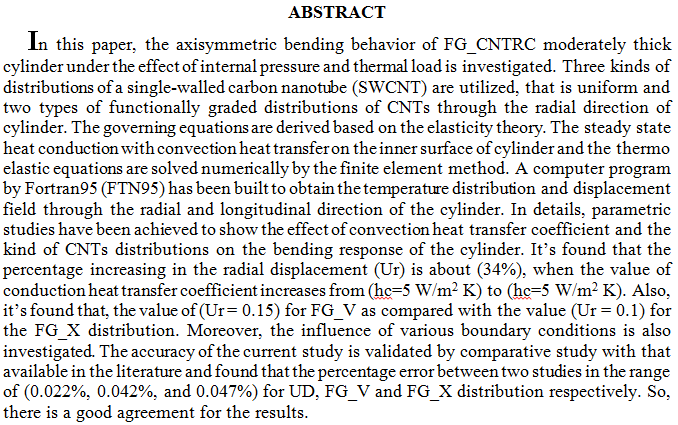
The main aim of this paper is studied the punching shear and behavior of reinforced concrete slabs exposed to fires, the possibility of punching shear failure occurred as a result of the fires and their inability to withstand the loads. Simulation by finite element analysis is made to predict the type of failure, distribution temperature through the thickness of the slabs, deformation and punching strength. Nonlinear finite element transient thermal-structural analysis at fire conditions are analyzed by ANSYS package. The validity of the modeling is performed for the mechanical and thermal properties of materials from earlier works from literature to decrea
... Show MoreBackground: The most widely used material for fabrication of denture base is poly methyl methacrylate, despite its popularity, the main problems associated with it as a denture base material are poor strength particularly under fatigue failure inside the patient mouth, impact failure outside the patient mouth, which are the main causes for fracture of denture, several studies was done to increase mechanical properties of denture base. The present study was conducted to evaluate and compare the effect of addition single walled carbon nanotubes in different concentrations to polymethyl methacrylate on some mechanical properties (surface hardness, surface roughness, impact strength and transverse strength). Materials and methods: Forty eight
... Show MorePharmaceutical-instigated pollution is a major concern, especially in relation to aquatic environments and drugs such as meropenem antibiotics. Adsorbents, such as multi-walled carbon nanotubes, offer potential as means of removing polluting meropenem antibiotics and other similar compounds from water. In order to evaluate the effectiveness of multi-walled carbon nanotubes in this capacity, various experimental parameters, including contact time, initial concentration, pH, temperature and the dose of adsorbent have been investigated. The Langmuir and the Freundlich isotherm models have been used. The data obtained using a modified Langmuir model have been consistent with the experimental ones; the best pH value has been obtained to have the
... Show More (3)
(3)
Geotechnical engineers have always been concerned with the stabilization of slopes. For this purpose,
various methods such as retaining walls, piles, and geosynthetics may be used to increase the safety factor of slopes prone to failure. The application of stone columns may also be another potential alternative for slope stabilization. Such columns have normally been used for cohesive soil improvement. Most slope analysis and design is based on deterministic approach i.e a set of single valued design parameter are adopted and a set of single valued factor of safety (FOS) is determined. Usually the FOS is selected in view of the understanding and knowledge of the material parameters, the problem geometry, the method of analysis and the
 (4)
(4)
 (16)
(16)
 (13)
(13)
Activated carbon (AC) is a highly important adsorbent material, as it is a solid form of pure carbon that boasts a porous structure and a large surface area, making it effective for capturing pollutants. Thanks to its exceptional features, AC is widely used for purifying water that is contaminated with odors and removing dyes in a cost-effective manner. A variety of carbonic materials have been employed to prepare AC, and this study aimed to evaluate the suitability of utilizing waste mango and avocado seeds for this purpose, followed by testing their efficacy in removing dye from aqueous solutions. The results indicate that using waste mango and avocado as AC is technically feasible, achieving dye removal percentages of 98% and 93%,
... Show MoreEfficient operations and output of outstanding quality distinguish superior manufacturing sectors. The manufacturing process production of bending sheet metal is a form of fabrication in the industry of manufacture in which the plate is bent using punches and dies to the angle of the work design. Product quality is influenced by plate material selection, which includes thickness, type, dimensions, and material. Because no prior research has concentrated on this methodology, this research aims to determine V-bending capacity limits utilizing the press bending method. The inquiry employed finite element analysis (FEA), along with Solidworks was the tool of choice to develop drawings of design and simulations. The ASTM E290
... Show More (2)
(2)
